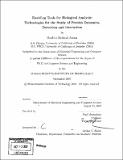Enabling tools for biological analysis : technologies for the study of protein dynamics, detection and interaction
Author(s)
Anwar, Moshiur Mekhail
DownloadFull printable version (17.39Mb)
Alternative title
Technologies for the study of protein dynamics, detection and interaction
Other Contributors
Massachusetts Institute of Technology. Dept. of Electrical Engineering and Computer Science.
Advisor
Paul Matsudaira.
Terms of use
Metadata
Show full item recordAbstract
The study of proteins in biological systems requires a comprehensive approach: investigating dynamics, interaction and identification. This thesis will examine several technological approaches we have developed to address these needs. To enable the study of the dynamics of biological systems, we have developed a method for using atomic force microscopy (AFM) to image motion on an angstrom scale with microsecond time resolution. As proteins move, diffuse, or are actively trafficked within the cellular environment, they interact with other biological molecules. Protein microarrays offer a high-throughput method of investigating these protein interactions, but their use has largely been hindered by the need to clone and purify thousands of proteins. We have developed a novel technique to pattern proteome-scale microarrays using a cellular lysate, whereby all relevant proteins are synthesized with the correct post-translational modifications. Additionally, we have integrated the identification of proteins with quantitative mass spectrometry (SILAC). Using these arrays we have probed changes in the phosphorylation state of cells in response to activation of the Erb1 and Erb2 receptors. Using our microarray platform we were able to further probe the phosphoproteome for proteins that have multiple post-translational modifications. The widespread use of protein, DNA and small molecule microarrays has been limited in clinical and diagnostic settings due to the cost of microarray readers. Therefore, we have developed an optics-free integrated circuit-based microarray imaging chip that is compatible with existing (optics-based) microarray protocols. By eliminating optics, and developing the reader using integrated circuit technology, the cost can be significantly reduced. The reader is powered by a single sine wave, enabling a wireless interface. We use this reader to detect a biotin-streptavidin interaction using standard microarray procedures.
Description
Thesis (Ph. D.)--Massachusetts Institute of Technology, Dept. of Electrical Engineering and Computer Science, 2007. Includes bibliographical references.
Date issued
2007Department
Massachusetts Institute of Technology. Department of Electrical Engineering and Computer SciencePublisher
Massachusetts Institute of Technology
Keywords
Electrical Engineering and Computer Science.